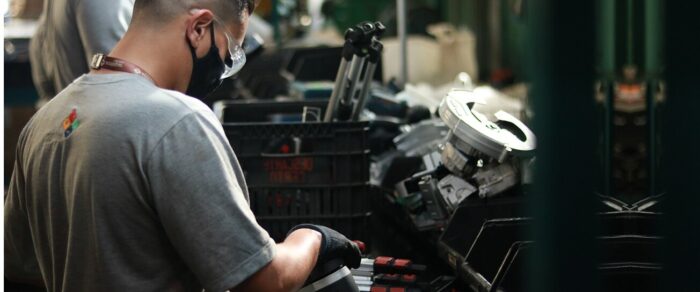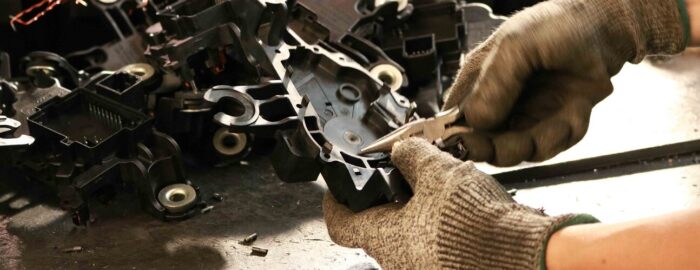
By Equipe de Redação
Posted in February 3, 2021

The circular economy is an important action to promote sustainability in the world and reduce carbon emissions in the atmosphere. The National Solid Waste Policy (PNRS) itself contemplates the reduction of waste generation and sustainable actions to avoid disposal in landfills. One is reverse logistics, but do you know what it is and how it works?
Industries make the products that are made available to businesses so you can buy and use them. When we discard it, it becomes a waste. Reverse logistics means collecting this material and taking it back to the generator for recovery. This can be done in several ways, depending on the segment in which the company operates, and brings economic, environmental and social benefits.
The reverse logistics step by step
1.Consumption
The consumer has the responsibility to make the correct disposal of the product, so that it is possible to collect and reinsert it into the production chain. Usually, the manufacturer provides information on the proper disposal of that product in the packaging itself. So, just read to know how to dispose of the material.
2. Collection
The distributor or dealer must send the product or packaging to the manufacturer. This can be done through collection points or sending expired or specified materials back to the industries.
3.Manufacturer
When the waste returns to the manufacturer or importer, it is necessary to make the final disposal environmentally correct. The company can decide whether to recycle or reuse the product in any other way. The fact is that the materials need to be disposed of correctly or valued, so that they return to the production chain as raw material or new product.
4.Reintroduction of waste in the production chain
From the moment the waste is reinserted in the production chain, it needs to be marketed again. Therefore, when they become new products, they return to the shelves of merchants or distributors to be sold.

The benefits of reverse logistics:
The companies that carry out reverse logistics have several environmental benefits and promote a circular economy, reducing the generation of waste and sending it to landfills. To explain in detail, we separate X benefits from reverse logistics:
1. Environmentally correct destination
The National Solid Waste Policy determines that companies must dispose of environmentally correct waste, aiming at promoting the circular economy and reducing waste generation. Based on reverse logistics, companies encourage the reuse, recycling or appropriate final disposal of waste. This contributes not only to comply with the legislation, but also with the ESG’s environmental index (Environment, Social, Governance).
2. Increase the useful life of landfills
By reducing the amount of waste generated or carrying out reverse logistics to recover it and reintroduce it into the production chain, it is possible to increase the useful life of landfills, since the practice allows reducing the amount of waste disposed in these locations. The big goal is to make the discarded material return to the manufacturer to be valued and sold as a new product on the market.
3. Increase the efficiency of natural resources
Natural resources are often finite, that is, they are depleted. Therefore, it is necessary to think about new, more sustainable forms of production, which reduce the extraction of natural resources from nature and can be reused several times, until it is impossible to return to the production chain. Reverse logistics is a great ally, since the discarded product returns to the manufacturer, is segregated and recycled.
4. Space to generate new business
Reverse logistics allows the generation of new businesses, since the original products are made of materials that can be recycled. The circular economy promotes logistics and reverse manufacturing, with this there are social, environmental and economic gains, from the generation of jobs and income, in addition to environmental preservation.
5. Shared responsibility in waste management
Responsibility for waste management is shared. The public sector provides the facilities for voluntary delivery points. The private sector has an obligation to install the collectors, carry out the withdrawal and carry out the appropriate final destination of the materials. Society has a responsibility to deliver the products to be disposed of at the appropriate collection points.
6. Compliance with legislation
The state of São Paulo, through the supervisory body Cetesb, requires companies that manufacture products contained in the sectorial agreements for reverse logistics, to perform the service, meeting the agreed percentages and targets. Companies that do not establish a program, as defined by law, are unable to renew their operating license.
How to apply reverse logistics?
After presenting the benefits of practicing reverse logistics, you need to understand how to apply it to your business. In fact, this type of implantation requires a personalized study, as it is necessary to evaluate which are the company’s products, how the commercialization works and understand the best way to apply reverse logistics.
It is necessary to define how the collection points will be, in which places they will be made available, how this waste will be transported to the company and understand the best form of final disposal for each type of material.
Ambipar is a leader in environmental management and offers logistics and reverse manufacturing services, defining specific programs for your company, according to the needs and guarantee of 100% waste traceability and protection of the customer’s brand.


Our business analysts are ready to help your company with the best environment solutions.